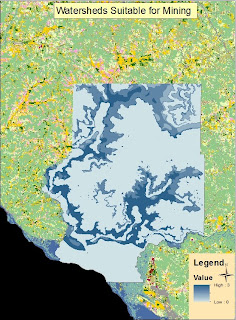Disorderly Conducts
report
City
residents have recently been complaining about the nature of the students in
the town of Eau Claire. Students are loud, obnoxious and disturb the peace. My
job as an independent researcher is to map the disorderly conduct violations
around Eau Claire for the years 2003 to 2009. With this data police officers will be able to
see if areas that have liquor and beer available are higher in disorderly
conduct reports. We can also set patrols for police officers in the areas more
prone to disorderly conduct to hopefully cut down the amount of disruption. With
the information supplied to me by the city of Eau Claire I will be able to set
up patrol routes for police as well as areas that need a heavy police force
presence.
Areas In Need of Police Presence
In
order to find out the areas that are in need of a heavy police influence it was
necessary to geocode all the disorderly conduct reports that were reported in
the years 2003 and 2009 these are the main arresting charges that are placed on
intoxicated individuals. Using the disorderly conduct report from 2003 and 2009
it was possible to find the mean center of the area. The mean center is the
area that is strictly in the middle of the highest concentration, theoretically
it is the highest area of arrests in this case. The weighted mean center is the
mean center with an attached outlier that will change the data slightly to an
area that may be having an effect on the data, in this case, the bars in Eau
Claire are the weight attached to the mean center.
Once
the mean center and the weighted mean center has been established a standard
distance would be necessary to establish a proximity around the mean center the
standard distance uses data to project a radius around projected points in
standard deviation. This will be a hot arrest zone where arrests are more
likely to happen in Eau Claire. This was established by using the arrest
records from 2003 and 2009 respectively.
Chloropleth Map of High Importence Areas
Also created was a standard deviation chloropleth map containing the mean center of
bars in Eau Claire. The standard deviation chloropleth map was used in order to
create a probability area based on calculated z-scores. Z- Scores are a way to
normalize data and create probability. The z- scores calculated were for 3
bars, based on the PolyID field these were 57, 46 and 41. Z score is calculated
by using the observed data subtract by the mean and divided by the standard
deviation. The calculations were zone 41 had an arrest percentage of 58% so disorderly
conduct was possible to happen in zone 41. Zone 57 had a negative arrest rate of
-56% so disorderly conduct was very unlikely to occur in this area. Zone 46
however had an incredible 445% arrest rate meaning disorderly conduct was
incredibly likely to occur in this area.
Using the data
that was provided by the Eau Claire City the conclusion that the
area most likely to have disorderly conduct was present in zone 46 of the
chloropleth map with regards to the z- score that calculated. This correlates
with the mean centers created with the 2003 and 2009 arrest data. While
the mean centers project the average area that arrests are taking place it
would be more accurate to use the weighted mean centers since they correlate
with the amount of bars in the area which projects a shift to the water street
area, this is the area that is very high in disorderly conduct arrests which in
turn should suggest that a high amount of police force will be required in this
area. While the water street area is high in arrests it would also be
beneficial to look at the weighted standard distance maps in order to create a
patrol route for the officers. This is the area that should be patrolled in
order to ensure the safety of the Eau Claire citizens since this is the
standard deviation where disorderly conducts occur.
In
conclusion, The amount of arrests in Eau Claire directly correlate to the
amount of alcohol that is served, using the weighted mean centers and standard
distance models we were able to find the area that is highest in disorderly
conducts as well as the area surrounding it. This will be beneficial in order
to create patrol routes for officers to follow and enforce the law. This
information also allows us to correlate the amount of officers that we have in
order to efficiently use them to our advantage and keep the city safer. A
higher amount of police presence in the standard distance area should help to
drastically cut down on the disorderly conducts that occur and will help to bring
peace to the city.






























